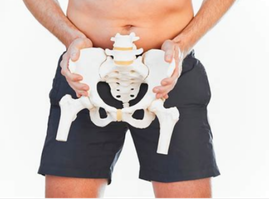|
The second chapter on men's pelvic stories is a more specific look at how men (and those who love them) can work through pelvic challenges, focusing on prostate cancer, surgery and treatment. The first chapter talked about the pelvic problems that a man may face. The good news is that with pelvic physiotherapy and a solid commitment to follow through with the work at home both before and after surgery and treatment, complete resolution of both leakage and impotence is possible. Each man will have varying severity and duration of these physical side effects and they can lead to a much reduced quality of life. You can rewrite your story with help.
The protocol that is described here leans heavily on the brilliant work of Jo Milios in Australia, a pelvic physio devoted to men's pelvic health and aided by over 3000 men who have had radical prostatectomies. Men who followed this protocol had much less leakage, much reduced duration of leakage and a much improved quality of life throughout their recovery time. Even more convincing is the statistic that 1 in 6 men had no leakage whatsoever! For 4 - 6 weeks prior to surgery and resuming immediately after surgery, men are taught the following protocol: six times daily, in a standing position, two exercises are performed. The first is 10 fast twitch (or speed 'ems) maximal (full on!) contractions and releases. These are followed by 10 slow twitch (endurance building or hold 'ems) contractions, holding each for 10 seconds with a 10 second relaxation time between each contraction. It's important to find "the right muscles". Try this: squeeze the front passage as if you're stopping the flow of urine, then lift your testes and retract the penis. Doing these exercises in standing is important as this is the position in which most men leak. With your pelvic physio, you'll learn awareness of which muscles activate correctly, then how to release fully and more! The importance of "pre-hab" or beginning training prior to surgery can't be reinforced enough. The time between biopsy/diagnosis and surgery is a time to begin learning about your pelvic function, strengthening and releasing. Bladder control (voiding with control and fully 6 - 8 x daily or learning to do so) and a happy bowel really make a difference as you head into the choppy waters of surgery and treatment. Jo's research has shown that men respond very well to the improved physical control of their waterworks and sexual function with this help, but additionally they are emotionally and relationally so much stronger! Her goal is to improve the quality of life for all undergoing prostate cancer diagnosis, surgery and treatment. Let's get specific....one appointment for assessment/training is sufficient to help you begin. Palpation can be done externally in most cases. Your important three muscles that control your urine, the trio that you need to learn to turn on and off and strengthen are called the external urethral sphincter + bulbocavernosus + puborectalis. Sometimes that pesky external anal sphincter gets dominant and you need to learn to teach it to quiet down. Once you've found these muscles, you'll move onto working in synergies, becoming powerful (for coughing and sneezing), strong (for sit to stand and lifting), having endurance (for standing and walking), improving the quality of contraction/lifting of the pelvic floor as well as improving release/relaxation in order to support the next contraction. The toughest bit? Fatigue. Standing upright will fatigue the system and that fatigue may worsen as the day progresses, causing leakage to occur. Many men will have overactive muscles that need to learn to release and NOT exercise at first (called pelvic downtraining), some men will vary
0 Comments
When I write about women's health, oncology (cancer related) and pelvic physio, it's a logical to assume that it's only women that we pelvic physios assess, treat and talk about. This is the first in a series of articles that will introduce you to the challenges that men face in their pelvic region, despite "being absolutely mortified to be discussing their private parts" (to quote Dr. Jo Milios, our lead teacher, a brilliant physio who had set up a non-profit organization in 2012 in Australia called PROST! Exercise for Prostate Cancer Inc.). Her passion is to educate all of us so that the everyday man on the street has better health outcomes and a much longer life.
Pelvic physiotherapy for men addresses loss of function in the pelvic region including prostate cancer pre-hab (prior to surgery and other treatments) and rehab, pelvic floor muscle dysfunction, urinary incontinence, painful urination, recurrent bladder infections, urinary frequency, bowel dysfunction, erectile dysfunction, chronic pelvic pain syndrome and Peyronie's Disease (a crooked or bent penis). Let's begin with the prostate. The prostate gland is a walnut sized donut shaped gland found right under the bladder and wrapped around the urethra (urine tube). Its job is to produce most of the fluid that makes up semen. The prostate can become inflamed (prostatitis, acute or nonbacterial) or enlarged (benign prostatic hyperplasia). Enlargement of the prostate doesn't mean it's cancerous and is usually noticed after age 40 during a regular doctor's visit. Prostate cancer is the most common cancer in North America and accounts for 11% of all cancer diagnoses in BC men; 1 in 9 males is expected to develop prostate cancer in their lifetime with 89% of them being over the age of 60 when they are diagnosed. There are some well known correlations (not causes) that may raise a man's risk of developing prostate cancer, including aging, family history, high levels of testosterone, being overweight, not exercising regularly and a poor diet. Large studies have shown that there is no correlation between having a vasectomy and prostate cancer. Yet again, Grandma's sage advice to exercise regularly, eat real good and maintain a healthy weight (for all cancers!) are actions that you can take to reduce your risk of developing prostate cancer. Your doctor (GP or urologist) or nurse practitioner may do a DRE (digital rectal examination) to palpate your prostate or you may have a PSA (blood test) to measure how much of a specific antigen is in your system. If you notice changes in your urination (stuttering flow, slow stream, painful, frequent, dribbling/double voiding, feeling the urge to bear down to start or finish, urge or loss of control, increased night time voiding or blood in your urine and/or painful ejaculation), please tell your doctor. Even though it's difficult or embarrassing to open up these conversations, your healthcare professional will want to know, will have had these conversations before and will make you comfortable sharing your story. Tell them! We pelvic physios become involved with men going through prostate surgery because most men (99%) will experience incontinence and erectile dysfunction. One of the prostate's secondary jobs it to support the bladder and to give neurological support of continence through the autonomic (involuntary) nervous system. The Cavernosal Nerves, responsible for erections, are wrapped around the prostate and they're usually damaged or removed in the process of the surgery. Each man will have varying degrees or severity and/or duration of physical side-effects of the surgery but please know that each man will generally improve over time. With pelvic pre-hab and rehab, complete resolution of both continence and sexual function is possible. It's all about restoring wonderful function and quality of life while reducing anxiety and depression, penile fibrosis and shrinkage and stopping the development of Peyronie's disease. Most importantly, men and partners who love men, talk with your doc if your experiencing pelvic dysfunction. In part 2 of this series, I'll share Dr. Milios' well researched brilliance after seeing >3000 men with radical prostatectomies, showing that, by using her protocol, men had less leakage (in amount and duration) with 1 in 6 men having no incontinence at all! |
Archives
January 2024
Categories
All
|




 RSS Feed
RSS Feed
